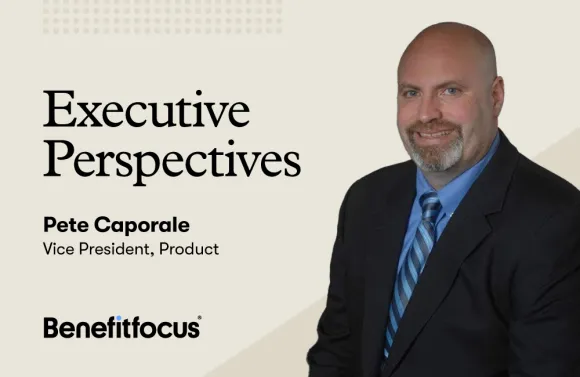
Summary
Price transparency is now essential for employee benefits cost containment. Read this blog to learn:
- Why it's crucial for brokers, TPAs and self-funded sponsors to connect negotiated rates to actual claims.
- How Benefitfocus integrates machine-readable file (MRF) data with claims reporting to allow plan sponsors to compare actual claims against market rates.
- The challenges with MRF data, including its volume, lack of standardization and data quality issues.
- Future developments in price transparency, which will likely include more enforcement, standardization and innovation.
This edition of Executive Perspectives is another insightful piece from Traci McGinnis, Vice President of Health Informatics. Traci shares her thoughts on the current state of price transparency and describes how the collaboration between Benefitfocus and Deerhold helps support clients.
Q: How would you describe the role of price transparency in employee benefits cost containment?
Traci: Price transparency may have started as a future goal, but it’s now a present-day necessity. Whether you're a broker advising clients, a third-party administrator (TPA) managing plan operations, or a self-funded sponsor accountable for every dollar spent, the ability to connect negotiated rates to actual claims has the potential to be transformative. Combining price transparency data with the optimal tools can give stakeholders the clarity and context they need to help decide on certain components in their cost containment strategy.
Q: Why is price transparency in health care considered more urgent now than ever before?
Traci: The regulatory landscape has shifted — Transparency in Coverage and Hospital Price Transparency rules are no longer theoretical. They’re enforceable, and they’re showing the true cost of care. But urgency isn’t just about compliance, it’s also about accountability. Employers are fiduciaries and are therefore responsible for how plan dollars are spent. And when nearly half of Americans say they can’t afford health care, we have a moral and operational imperative to act. Price transparency gives us the data to do better—for our customers and their members, plans, and their bottom lines.
Q: You mentioned that price transparency is a transformative practice for brokers, TPAs and self-funded sponsors. How can each of these stakeholders benefit from price transparency?
Traci: It’s important to recognize that price transparency is driven by regulations, but it can also be used in a strategic manner. And depending on your role in the benefits ecosystem, it offers different kinds of value.
For Brokers: Transparency is a differentiator. Brokers are under pressure to deliver optimal plan designs, and they’re also expected to provide data-driven insights. By using a solution that integrates price transparency, brokers can show clients how their negotiated rates compare to market benchmarks, identify high-cost providers, and offer guidance on smarter network configurations. It’s not just about selling; it’s about advising with credibility.
For TPAs: TPAs are the operational backbone of self-funded plans. But without visibility into negotiated rates and actual payments, they’re flying blind. The integration of machine-readable file data into claims reporting gives TPAs the tools to validate pricing, flag anomalies, and support fiduciary oversight. It’s about operational integrity and protecting the plan from unnecessary spend.
For Self-Funded Plan Sponsors: This is where the rubber meets the road. Sponsors are fiduciaries. They’re responsible for every dollar spent. Price transparency gives them the power to ask hard questions: Why did we pay 3x the market rate for a procedure? Why is one provider consistently more expensive? But answering these questions is just the first step; sponsors also need options. A solution that supports price transparency can be most effective when it provides answers and options to renegotiate, reconfigure, and realign their strategy with their values.
Q: How is Benefitfocus approaching the integration of price transparency data, and how is it different from other solutions?
Traci: What sets us apart is how we connect the dots. Vendors in the market offer access to cleansed and aggregated machine-readable file (MRF) data, and query tools to access those rates. That’s useful, but more can be done. We’re going further by tying those fee-for-service negotiated rates directly to what was actually paid on the claim. And we’re doing it at the procedure level, by provider.
This isn’t just a data mashup; it’s a strategic integration. We’re joining MRF data with claims reporting inside Health Insights, so plan sponsors can see, side-by-side, what the market rate is and what they paid. That’s powerful. It allows them to identify pricing outliers, validate network performance, and hold vendors accountable in a way that’s traceable and defensible.
Others may offer MRF data as a standalone purchase, but we’re embedding it into the analytics workflow. That’s why our approach is different and why it resonates with fiduciaries who need more than just transparency. They need clarity, context, and control.
Q: Machine-readable files (MRFs) are an important component in TiC and Hospital Price Transparency regulations. How is Benefitfocus leveraging MRF data to support clients?
Traci: We’ve taken a bold step forward. Through our collaboration with Deerhold, Ltd., we’re ingesting MRFs from major carriers — those massive datasets that contain negotiated rates between payers and providers. We’ve integrated that data into Health Insights, so clients can benchmark their actual claims against market rates. This isn’t just about charts and graphs, it’s about empowering plan sponsors to identify outliers, optimize networks, and make data-driven decisions that are intended to improve outcomes and reduce waste.
Q: Although machine-readable files are processed by computers, humans still play a role in determining how to use the data effectively. What are the biggest challenges you’ve seen in using MRF data?
Traci: The release of machine-readable files (MRFs) under the Transparency in Coverage rule was a crucial moment for health care price transparency. However, it’s created some significant challenges for those of us responsible for turning this data into actionable insights. MRFs might be used for benchmarking, analytics or consumer tools, and the processes are far more complex than simply downloading a file.
Here are the biggest challenges I’ve seen when trying to use MRF data effectively:
1. The Sheer Volume of Data
These files are enormous. We're talking gigabytes to terabytes of data per payer, updated monthly. That means you need serious infrastructure just to ingest and store the data, let alone analyze it. For organizations without cloud-based pipelines or big data capabilities, this is likely a non-starter.
2. Structural Complexity and Lack of Standardization
While Centers for Medicare & Medicaid Services (CMS) provides a framework, payers may interpret it differently. File structures, naming conventions, and even the way rates are reported vary widely. This lack of standardization makes it incredibly difficult to compare data across payers or build scalable tools that work universally.
3. Data Quality and Consistency Issues
Even when you get the data loaded, you’re not out of the woods. We routinely see multiple rates for the same provider and service, implausible entries (like psychiatric hospitals listing cardiac surgery rates), and missing or vague fields. These inconsistencies make it hard to trust the data without extensive validation and cleansing.
4. Medical Coding Complexity
The files rely heavily on Current Procedural Terminology (CPT), Healthcare Common Procedure Coding System (HCPCS), and other medical codes. That’s fine if you’re a clinician or coder, but for data scientists or product teams, it adds a layer of complexity that requires domain expertise. And even then, coding discrepancies between payers and providers can muddy the waters.
5. Accessibility and Usability
These files are designed to be machine-readable, not human-readable. This means the data is virtually unusable without specialized tools. There are very few public platforms that make this data accessible to researchers, consumers, or even health care professionals in a meaningful way.
6. Compliance vs. Practical Utility
Many payers are technically compliant; they’ve posted the files, but the data may be structured in ways that make it hard to use. Some files are buried behind login walls, others are split into thousands of fragments, and some are just poorly formatted. The spirit of transparency can be lost in execution.
Q: You’re currently part of the Price Transparency Committee which was formed by the Self-Insurance Institute of America (SIIA). How does this role help shape the product strategy at Benefitfocus?
Traci: Being part of the Price Transparency Committee has been invaluable. I’ve had the opportunity to contribute to legislative language and help shape the fiduciary education agenda. It’s given me a front-row seat to the policy shifts that are coming, and the ones that are already here. That perspective informs the ideas of how we can evolve our products and services at Benefitfocus from a fiduciary lens. We’re not just building tools; we’re building solutions that anticipate regulatory scrutiny and support fiduciary best practices.
Q: How do you see price transparency evolving in the next 2–3 years?
Traci: We’re likely going to see more enforcement, more standardization, and more innovation. The Lower Costs, More Transparency Act is already pushing for public Rx pricing in machine-readable files (MRFs) and requiring Pharmacy Benefit Managers (PBMs) to disclose rebates and discounts. That’s huge. On our end, we’ll continue to evolve the ways this data can be connected to claims and analyzed, to bring valuable fiduciary insights to clients. The goal is to give plan sponsors the clarity they need to manage costs proactively, without having to hire technical teams or invest in massive infrastructure.
Q: What guidance would you give to plan sponsors navigating this landscape?
Traci: Start with procurement. Before you even get to analytics or benchmarking, make sure your contracts and vendor relationships are built on transparency. Review your Administrative Services Only (ASOs) and Pharmacy Benefit Manager (PBM) agreements and look for gag clauses, audit restrictions, and any language that limits your access to claims data. If there’s anything blocking access, work on removing it.
From there, move into governance by documenting your fiduciary roles and responsibilities. Make sure your committee understands what price transparency means, both in theory and in practice. Consider using tools like Health Insights to monitor claims for payment accuracy and benchmark against market rates. Don’t just look at what you paid — look at what you should have paid.
And finally, stay engaged. Join advocacy groups like SIIA. Track legislation. Hold your partners accountable. Because fiduciary risk isn’t theoretical anymore; it’s real, and it’s rising. Transparency isn’t just a compliance issue; it’s a leadership opportunity.


